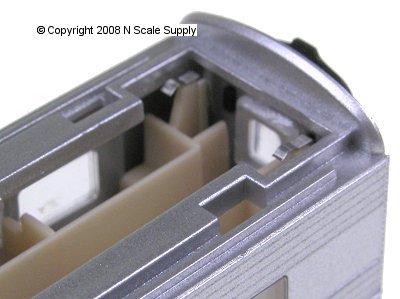|



A six white
LED lighting kit is sold separately.
The above piece installs face down and touches the electrical
contacts shown below.


Here the
lighting kit has been snapped into place. The roof will snap
into this.
| Features: |
- All
New Tooling
- Accumate
Operating Couplers
- All
Detail Parts Added
- Metal
Wheelsets
|
When
lightweight cars came to the Pullman fleet in the early
1940s, their smooth sides lent themselves to classy, colorful
paint schemes. Corrugated stainless-steel sides, later
added to match the look (and acknowledge the competition)
of Budd's stainless-steel designs, created a variety of
cars that ran on premier passenger trains.
Based on Plan #7484, the Walthers Pullman-Standard 64-Seat
Coaches feature roadname-appropriate body styles with
corrugated or smooth sides, with or without skirting.
The cars ride on GSC 41-N trucks with blackened metal
wheels. Other features include flush-fitting windows,
full interiors, working diaphragms, Accumare(R) knuckle
couplers, car number and name decals and factory-installed
electrical pickups for drop-in interior lighting kit #933-1099
(sold separately). |
|